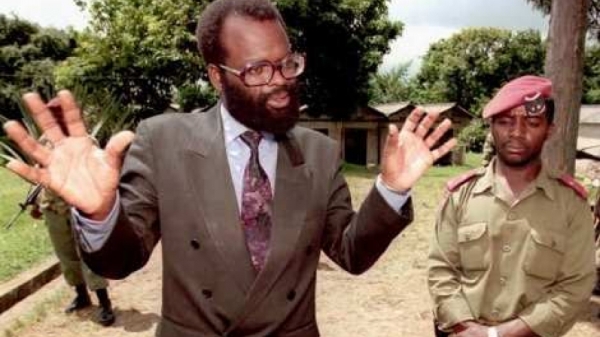
Jean Kambanda
By Dr BIZIMANA Jean Damascène*
Between May 25 and 30, 1994, the criminal government was constantly defeated by the RPF-INKOTANYI forces. Hence, the former put more efforts in distributing guns, grenades and ammunition to the Interahamwe and government forces to accelerate the genocide. The government has also made efforts to mobilize the public to make them understand that they must join the genocide plot to exterminate Tutsi wherever they are.
1. Publication of the genocide acceleration regulations in the so-called “auto-defense civile”
On May 25, 1994, the criminal government led by Jean Kambanda issued written instructions to all prefects giving them the directions to accelerate the extermination of the Tutsi. The instructions were included in the so called “auto-defense civile” program (meaning: civilian self-protection) which was intended to intensify the mobilization of Hutu population by urging them to join the genocide plan falsely claiming it was kind for auto defending. They had made up a lie that Tutsi who had not yet been killed had established brigades all over the country trained by the Inkotanyi to kill the Hutu.
The second major feature of the instructions was the establishment of a system of continuous supply of guns, grenades, ammunition and machetes to areas where there were still Tutsi like in Bisesero where they were still defending themselves using traditional weapons.
The Ministers were instructed to travel to the prefectures not yet liberated by the RPF-INKOTANYI forces to announce the killing instructions and join forces with the criminal government soldiers and gendarms to provide necessary equipment to accelerate the genocide. Minister of Information Eliezer Niyitegeka and Edouard Karemera, who was the Minister of interior administration, were given a mission to accelerate the genocide among the Tutsi in Kibuye Prefecture.
Eliezer Niyitegeka and Edouard Karemera were prosecuted by the International Criminal Tribunal for Rwanda and were convicted of genocide crime and sentenced to life in prison. Eliezer Niyitegeka died in prison in Mali on March 28, 2018.
As for Minister Callixte Nzabonimana, the former Minister of the youth and organizations, was given special mission to continue leading the massacre of Tutsi in Gitarama Prefecture and he accomplished the mission. Nzabonimana was also tried by the International Criminal Tribunal for Rwanda (ICTR) and sentenced to life imprisonment on May 31, 2012.
Butare Prefecture was in the hands of Pauline Nyiramasuhuko, the former Minister of family promotion who was also convicted of genocide crime in the International Criminal Tribunal for Rwanda and sentenced to 47 years in prison.
In the International Criminal Tribunal for Rwanda (ICTR), the former Prime Minister of the genocidal Government, Jean Kambanda, pleaded guilty to the crimes committed in the context of civil self-defense during the genocide against the Tutsi, indicating that this program was a criminal character planned by his Government with the aim of exterminating the Tutsi.
2. The UN Secretary General finally confirmed genocide in Rwanda
On May 25, 1994, Boutros Boutros-Ghali, the former Secretary General of the United Nations, declared that the killing which was taking place in Rwanda was genocide. The UN Secretary General also said that failing to deploy troops to Rwanda was a defeat for the United Nations and the international community in general.
On the same day, the United Nations Commission on Human Rights, based in Geneva, Switzerland, convened a meeting during which they also confirmed that genocide was taking place in Rwanda. Additionally, they appointed an expert from Ivory Coast, Mr. Rene Dégni- Ségui and was tasked to go to Rwanda and investigate the nature of the killings and report back.
Still on the same day, the International Commission of Jurists (ICJ) requested the United Nations General security council to do its utmost and prosecute the perpetrators of the genocide in Rwanda. The Commission recommended that the UN Security Council expand the responsibilities of the International Criminal Tribunal for the Yugoslavia in order to prosecute the perpetrators of the Genocide against the Tutsi in Rwanda
3. Some Ex-FAR soldiers had split from the criminal government army and the country was progressively liberated by the RPF-INKOTANYI
On May 27, 1994, some of the high ranking Ex-FAR soldiers, including Captain François Munyurangabo split from those who were committing genocide. Captain Munyurangabo seized a Government – owned plane which he had taken to Dar-es-Salam and took it to Nairobi and announced that he had joined the RPF-INKOTANYI to continue the struggle for national liberation.
On May 29, 1994, RPF-INKOTANYI forces captured the city of Nyanza and rescued few Tutsi who had not been killed. The next day, on May 30, 1994, RPF-INKOTANYI forces captured Ruhango City. The criminal government forces realised that the RPF-INKOTANYI forces were putting pressure on the former and defeated them day by day, stimulating the genocidal government to call on the United Nations to help them negotiate with the RPF-INKOTANYI.
CONCLUSION
As the criminal government forces were progressively defeated by the RPF-INKOTANYI forces, the genocide was stopped in different parts of the country by the RPF-INKOTANYI. This triggered the criminal government’s efforts to exterminate Tutsi where they were still alive. In the last days of May 1994, more than a million Tutsi had already been massacred in all prefectures of Rwanda. The so-called auto-defense civile program, which involved distribution of weapons, ammunition and grenades played a major role. Although accelerated during the genocide, the auto-defense civile program had been in place since 1991 and was part of an open plot to exterminate the Tutsi.(End).
* Dr BIZIMANA Jean Damascène, Executive Secretary National Commission for the Fight against Genocide (CNLG)
